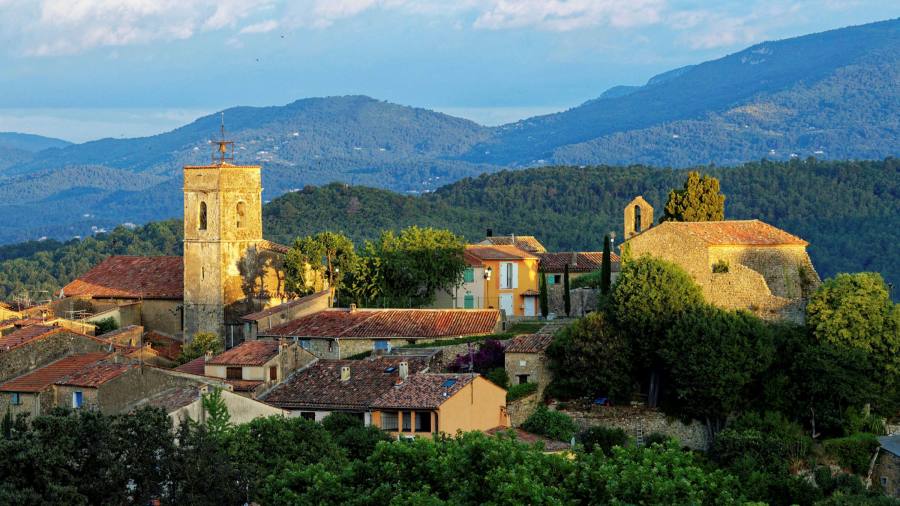Alan Duguid and his wife have long dreamt of retiring to a place beside the Mediterranean. But when the couple from the UK started looking for a home that matched their requirements — four bedrooms, enough land not to be overlooked and a decent-sized swimming pool — they soon realised they were going to struggle to find it among the popular resorts of the Côte d’Azur.
“We had visited Cannes, Antibes, St Tropez, all the way up to Grasse — but the houses were just too close together,” he says. The surge of tourists in the summer months meant little peace and the sprawl of these once-contained towns meant no chance of finding a home within a morning walk to the local high street for a coffee and breakfast. “You had to get in your car to reach a shop or an identifiable centre.”
Then there was the price. Even if he found one of the rare homes with a good-sized garden and some privacy, Duguid says it would cost more than double their €900,000 budget. So earlier this year, the couple changed tack, buying a detached home with a pool in Saint-Paul-en-Forêt, an unassuming hilltop village about 20km inland. Duguid says he enjoys a sense of seclusion he would never have found on the coast. “And it’s half an hour by car to Cannes.”
After years of rising prices in southern Europe’s holiday hotspots, many property buyers are, like Duguid, turning to lesser-known and more affordable alternatives. And it’s not just the cheaper price tags on offer — many say that outside of the region’s tourist-clogged resorts they can find a more authentic Mediterranean way of life.

A 15-minute drive from the glitz of St Tropez, La Croix-Valmer — with a good crop of restaurants, secluded beaches and far cheaper homes than its neighbour — is growing in popularity.
Inland from Cannes, other hill towns and villages including Claviers, Seillans, Montauroux and Fayence are attracting growing interest. “Parisians and Lyonnais have been making a beeline to the Fayence area for this past couple of years, as have many German, Dutch, Scandinavian and British clients,” says Tim Swannie of local agent Home Hunts.
“It’s never too busy and it feels like a more authentic location [than Cannes]. And the temperature never gets above mid-30s; on the coast it’s a sweatbox,” says David, a UK tax adviser, of the Fayence home he bought shortly before the pandemic. He was prepared to spend more money for a home on the edge of Cannes, but couldn’t see the extra value: for €840,000 in Fayence he has a detached home with five bedrooms, a 12-metre pool and extensive gardens.
In Portugal’s Algarve, where prices have risen 29 per cent since 2019, according to Savills, an increasing number of people are heading beyond prestigious costly locations such as Vale do Lobo and Vilamoura to Monchique, the mountain town with a good supply of 1980s and 1990s villas ripe for renovation, located just 20 minutes from the coast.
In Spain, those seeking alternatives to Barcelona are looking up the coast to Mataró, Premià de Mar and Alella.

In Italy, Fabio Cenci is preparing to move permanently from Rome, where he has lived for most of his life, to Lanzo d’Intelvi, a hillside village about 15km from the shores of Lake Como. A year ago, he bought a home there with three bedrooms, mountain views and a good-sized garden. Sara Zanotta of Lakeside Real Estate, a local agent, says an equivalent home above Lake Como would cost double what Cenci paid.
Thanks to rising prices around Lake Como, average home prices in the prestigious lakeside area of Tremezzina are now €3,542 per sq m, according to Italian property website Immobiliare.it. Those in Lanzo d’Intelvi are €1,154 per sq m. Further south, in the hills above Como’s eastern shores, the towns of Molina and Lemna are also proving popular.
Serena Emanuelli, who runs La Locanda del Notaio, a hotel and restaurant in the village, says Italians rediscovered the valley d’Intelvi following the pandemic: today two-thirds of her customers are Italian, up from a quarter in 2019.
“They continue to [visit], thanks to the rapprochement with nature and passion for the mountains that many developed during the pandemic,” she says.

In addition to being cheaper than Como, Cenci’s new home offers better hiking and the hillside location saves him from the worst of the summer heat, he says. “I could never have afforded Como. And this is the house I always dreamt of. It’s in a wooded area close to the mountains — meaning it is fresher during the summer — but also close to the cities of Lugano and Como.”
Prices in Lisbon, on Portugal’s Atlantic coast, have doubled since 2015, with continued buying through the pandemic, according to Savills. Last year’s booming cryptocurrency prices — which have been reducing in recent weeks — resulted in competition among newly minted traders for the largest homes, according to Charles Roberts of agent Fine and Country in Lisbon. This group accounted for just a handful of his buyers before the pandemic, he says.
“Today they are more than a third. We had 32-year-old crypto millionaires with budgets of €10mn. So people lower down the scale are looking to cheaper spots they can work remotely from.”
Many of those with smaller budgets choose Tomar, 90 minutes by car north-east of the city, popular among Portuguese outdoor types thanks to the nearby lake to its east.

Paul Dredge moved to Tomar from the UK in 2009. Before the pandemic, he bought a detached house, which he is now renovating. He prefers the authentic experience of the town to Portugal’s more established destinations, such as the Algarve, long popular with the British.
“We used to holiday in Portugal but we never liked the all-day English breakfasts or the Irish bars. When we moved out here, we wanted to be in the real Portugal rather than in an enclave of English people,” he says.
Paulo Carvalho has seen the impact of Tomar’s growing popularity in a healthy boost to his business. Sales at his water sports equipment shop have grown by more than 50 per cent since 2019, quicker than at any time since he launched it in 2002. In November, he moved the warehouse and shop to a larger site, allowing him to expand his stock and develop his online business throughout Portugal.
“The lake is busier all the year round now; many local homeowners you used to see only during the summer have moved permanently. The wake surf and wake board schools are now always full; they keep asking us for more boards, vests, gloves and so on,” he says.
Rising property prices across many of the Mediterranean’s most popular cities have provoked a backlash in recent years as many locals struggle to afford a home.

There may yet be such a reaction from locals in Bellac, a small village with a medieval church and centre about an hour’s drive north of Dordogne in France. For now, though, its traders are — like Carvalho — welcoming the boost.
For several years, new shops have been opening along the main street at a steady rate. Today they include a butcher, two antiques shops, a bicycle repair and rental shop, a jewellery design shop and an insurance shop. A few days ago, a new bar with chic industrial- style interiors opened its doors.
“The high street has definitely got busier,” says Natalie Fletcher, who moved to Bellac from Australia. She runs the jewellery shop and has focused on contemporary designs to appeal to the growing younger population of the town. There are more professional types in their thirties to mid-forties, she says: “Many are from Bordeaux, some are now télétravailleurs.”
It’s never too busy and it feels more authentic than Cannes. And temperatures never get above the mid-30s
Sarah Engel is one recent arrival who has been both a contributor to and beneficiary of the town’s growing economy. Unable to afford a home in Paris, where she and her husband lived, the couple bought a holiday home in Bellac in 2019, where she had spent vacations for eight years. When she lost her job in tourism last year, they moved to Bellac full time.
“Within a matter of weeks, I felt I knew a lot of people. It just felt like home: you could say hello to anyone. People really look to help each other: there’s a real sense of community,” she says.
Today, she works as a freelance graphic designer and enjoys a subsidised rent on her desk in a co-working space set up to help develop local businesses and community groups. “Eight years ago, it was a bit of a ghost town. Shops were closing, there were lots of old people. No one was out after 7pm. Now I can even get my nails done!”
Find out about our latest stories first — follow @FTProperty on Twitter or @ft_houseandhome on Instagram
Letter in response to this article:
Stick to the coast to avoid Med property sweatbox / From Wendy Lee, Gruissan, Aude, France



